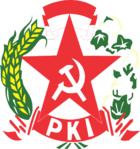المقتلة الإندونيسية 1965–1966
| المذابح الإندونيسية 1965–1966 | |
|---|---|
| جزء من الانتقال إلى النظام الجديد | |
| المكان | إندونيسيا |
| التاريخ | 1965–1966 |
| الهدف | PKI members, sympathizers, atheists, "unbelievers", and ethnic Chinese[1] |
نوع الهجوم | Politicide, mass murder, genocide[1] |
| الوفيات | 500,000[2] to 3,000,000[3][4] |
| المنفذون | Indonesian Army and various death squads, facilitated and encouraged by the United States and other Western governments[5][6][2] |
| هذا المقال هو جزء من سلسلة تاريخ إندونيسيا |
|---|

|
| انظر أيضاً: |
| قبل التاريخ |
| الممالك المبكرة |
| سري ڤيجايا (القرون الثالث إلى الرابع عشر) |
| تاروما نگارا (358-723) |
| سايلندرا (القرنان الثامن والتاسع) |
| مملكة سوندا (669-1579) |
| مملكة مطرم (752–1045) |
| كديري (1045–1221) |
| سنغاساري (1222–1292) |
| ماجاپاهيت (1293–1500) |
| نشأة الدول الإسلامية |
| انتشار الإسلام (1200–1600) |
| سلطنة ملقا (1400–1511) |
| سلطنة دماك (1475–1518) |
| سلطنة آچه (1496–1903) |
| سلطنة بانتن (1526–1813) |
| سلطنة مطرم (1500s to 1700s) |
| الاستعمار الاوروبي |
| البرتغاليون (1512–1850) |
| شركة الهند الشرقية الهولندية (1602–1800) |
| الهند الشرقية الهولندية (1800–1942) |
| بزوغ إندونيسيا |
| الصحوة الوطنية (1899–1942) |
| الاحتلال الياباني (1942–45) |
| إعلان الإستقلال (1945) |
| الثورة الوطنية (1945–1950) |
| إندونيسيا المستقلة |
| الديمقراطية الليبرالية (1950–1957) |
| الديمقراطية المهدية (1957–1965) |
| بداية النظام الجديد (1965–1966) |
| النظام الجديد (1966–1998) |
| عصر الإصلاح (1998–الحاضر) |
| عدّل هذا القالب |
The Indonesian mass killings of 1965–1966 (also variously known as the Indonesian massacres, Indonesian genocide,[7][1][2] Indonesian Communist Purge, Indonesian politicide,[8][9] or the 1965 Tragedy) were large-scale killings and civil unrest that occurred in Indonesia over several months, targeting communist sympathizers, ethnic Chinese and alleged leftists, often at the instigation of the armed forces and government. It began as an anti-communist purge following a controversial attempted coup d'état by the 30 September Movement in Indonesia. The most widely published estimates were that 500,000 to more than one million people were killed,[2][10][11][12] with some more recent estimates going as high as two to three million.[3][13] The purge was a pivotal event in the transition to the "New Order" and the elimination of the Indonesian Communist Party (PKI) as a political force, with impacts on the global Cold War.[14] The upheavals led to the fall of President Sukarno and the commencement of Suharto's three-decade authoritarian presidency.
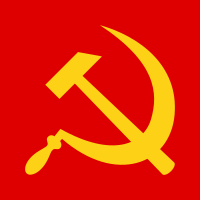
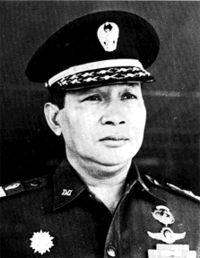
The claims of a coup attempt by Communists released pent-up communal hatreds; these were fanned by the Indonesian Army, which quickly blamed the PKI. Communists were purged from political, social, and military life, and the PKI itself was disbanded and banned. The massacres began in October 1965, in the weeks following the coup attempt, and reached their peak over the remainder of the year before subsiding in the early months of 1966. They started in the capital, Jakarta, and spread to Central and East Java, and later Bali. Thousands of local vigilantes and army units killed actual and alleged PKI members. Killings occurred across the country, with the worst in the PKI strongholds of Central Java, East Java, Bali, and northern Sumatra. It is possible that over one million people were imprisoned at one time or another.
Sukarno's balancing act of "Nasakom" (nationalism, religion and communism) had unravelled. His most significant pillar of support, the PKI, was effectively eliminated by the other two pillars—the army and political Islam; and the army was on the way to unchallenged power. In March 1967, Sukarno was stripped of his remaining power by Indonesia's provisional Parliament, and Suharto was named Acting President. In March 1968, Suharto was formally elected president.
The killings are skipped over in most Indonesian history textbooks, and have received little introspection by Indonesians, due to their suppression under the Suharto regime. The search for satisfactory explanations for the scale and frenzy of the violence has challenged scholars from all ideological perspectives. The possibility of a return to similar upheavals is cited as a factor in the "New Order" administration's political conservatism and tight control of the political system. Vigilance and stigma against a perceived communist threat remained a hallmark of Suharto's doctrine, and it is still in force even today.[15]
Despite a consensus at the highest levels of the US and British governments that it would be necessary "to liquidate Sukarno", as related in a CIA memorandum from 1962,[16] and the existence of extensive contacts between anti-communist army officers and the US military establishment – training of over 1,200 officers, "including senior military figures", and providing weapons and economic assistance[17][18] – the CIA denied active involvement in the killings. Declassified US documents in 2017 revealed that the US government had detailed knowledge of the mass killings from the beginning, and was supportive of the actions of the Indonesian Army.[5][19][20] US complicity in the killings, which included providing extensive lists of communist party officials to Indonesian death squads,[26] has previously been established by historians and journalists.[19][14] A top-secret CIA report from 1968 stated that the massacres "rank as one of the worst mass murders of the 20th century, along with the Soviet purges of the 1930s, the Nazi mass murders during the Second World War, and the Maoist bloodbath of the early 1950s."[27][28]
خلفية
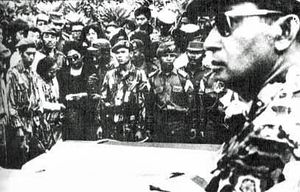
التطهير السياسي
المذابح
—Time, 17 December 1965.
جاوة
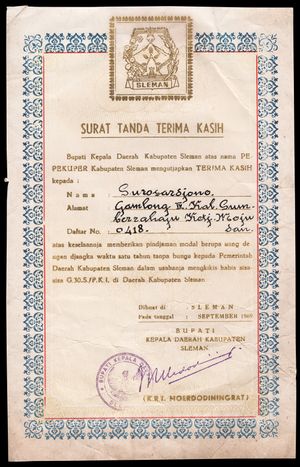
التورط الأجنبي
—Robert J. Martens, political officer at the US Embassy in Jakarta, who provided lists of communists to the Indonesian military.
الذكرى
التاريخانية
انظر أيضاً
- Communist Party of Indonesia
- Gerwani
- Communism in Sumatra
- Indonesian occupation of East Timor
- List of massacres in Indonesia
- Petrus Killings
- 40 Years of Silence: An Indonesian Tragedy, a 2009 documentary film
- The Act of Killing, a 2012 documentary film
- The Look of Silence, a 2014 documentary film
- Politicide
- United States involvement in regime change
Notes
- ^ أ ب ت خطأ استشهاد: وسم
<ref>غير صحيح؛ لا نص تم توفيره للمراجع المسماةMelvin - ^ أ ب ت ث Robinson, Geoffrey B. (2018). The Killing Season: A History of the Indonesian Massacres, 1965–66. Princeton University Press. ISBN 978-1-4008-8886-3.
- ^ أ ب Indonesia's killing fields. Al Jazeera, 21 December 2012. Retrieved 24 January 2016.
- ^ "Looking into the massacres of Indonesia's past". BBC News. 2 June 2016. Retrieved 3 July 2017.
- ^ أ ب Melvin, Jess (20 October 2017). "Telegrams confirm scale of US complicity in 1965 genocide". Indonesia at Melbourne. University of Melbourne. Retrieved 21 October 2017.
The new telegrams confirm the US actively encouraged and facilitated genocide in Indonesia to pursue its own political interests in the region, while propagating an explanation of the killings it knew to be untrue.
- ^ خطأ استشهاد: وسم
<ref>غير صحيح؛ لا نص تم توفيره للمراجع المسماةSimpson2010 - ^ Robert Cribb (2004). "The Indonesian Genocide of 1965–1966." In Samuel Totten (ed). Teaching about Genocide: Approaches, and Resources. Information Age Publishing, pp. 133-143. ISBN 159311074X
- ^ Roosa, John. "The 1965–66 Politicide in Indonesia: Toward Knowing Who Did What to Whom and Why". Stanford.
- ^ "The Indonesian Politicide of 1965–66: How Could it Have Happened?". Maastricht University.
- ^ Melvin, Jess (2018). The Army and the Indonesian Genocide: Mechanics of Mass Murder. Routledge. p. 1. ISBN 978-1-138-57469-4.
- ^ Mark Aarons (2007). "Justice Betrayed: Post-1945 Responses to Genocide." In David A. Blumenthal and Timothy L. H. McCormack (eds). The Legacy of Nuremberg: Civilising Influence or Institutionalised Vengeance? (International Humanitarian Law). Martinus Nijhoff Publishers. ISBN 9004156917 p. 80.
- ^ The Memory of Savage Anticommunist Killings Still Haunts Indonesia, 50 Years On, Time
- ^ Gellately, Robert; Kiernan, Ben (July 2003). The Specter of Genocide: Mass Murder in Historical Perspective. Cambridge University Press. pp. 290–291. ISBN 0-521-52750-3. Retrieved 19 October 2015.
- ^ أ ب خطأ استشهاد: وسم
<ref>غير صحيح؛ لا نص تم توفيره للمراجع المسماةAtlantic2017 - ^ Varagur, Krithika (23 October 2017). "Indonesia Revives Its Communist Ghosts". U.S. News & World Report. Retrieved 23 October 2017.
- ^ Allan & Zeilzer 2004, p. ??.
Westad (2005, pp. 113, 129) notes that, prior to the mid-1950s—by which time the relationship was in definite trouble—the US actually had, via the CIA, developed excellent contacts with Sukarno. - ^ http://hdl.handle.net/2027/uc1.b3605665?urlappend=%3Bseq=440
- ^ Macaulay, Scott (17 February 2014). The Act of Killing Wins Documentary BAFTA; Director Oppenheimer’s Speech Edited Online. Filmmaker. Retrieved 12 May 2015.
- ^ أ ب "Files reveal US had detailed knowledge of Indonesia's anti-communist purge". The Associated Press via The Guardian. 17 October 2017. Retrieved 18 October 2017.
- ^ Dwyer, Colin (18 October 2017). "Declassified Files Lay Bare U.S. Knowledge Of Mass Murders In Indonesia". NPR. Retrieved 21 October 2017.
- ^ أ ب خطأ استشهاد: وسم
<ref>غير صحيح؛ لا نص تم توفيره للمراجع المسماةKadane - ^ خطأ استشهاد: وسم
<ref>غير صحيح؛ لا نص تم توفيره للمراجع المسماةLA Times - ^ خطأ استشهاد: وسم
<ref>غير صحيح؛ لا نص تم توفيره للمراجع المسماةCIA lists - ^ خطأ استشهاد: وسم
<ref>غير صحيح؛ لا نص تم توفيره للمراجع المسماةAlexBellamy - ^ خطأ استشهاد: وسم
<ref>غير صحيح؛ لا نص تم توفيره للمراجع المسماةEditorial Note - ^ [21][22][23][24][25]
- ^ Mark Aarons (2007). "Justice Betrayed: Post-1945 Responses to Genocide." In David A. Blumenthal and Timothy L. H. McCormack (eds). The Legacy of Nuremberg: Civilising Influence or Institutionalised Vengeance? (International Humanitarian Law). Martinus Nijhoff Publishers. ISBN 9004156917 p. 81.
- ^ خطأ استشهاد: وسم
<ref>غير صحيح؛ لا نص تم توفيره للمراجع المسماةDavid F. Schmitz 2006 48-49 - ^ Bodenheimer, Thomas; Gould, Robert (1999). Rollback!: Right-wing Power in U.S. Foreign Policy. South End Press. pp. 29–30. ISBN 0-89608-345-4.
References
- Alham, Asahan, ed. (2002). Di Negeri Orang: Puisi Penyair Indonesia Eksil [In Another Person's Country: Poems By Exiled Indonesian Poets] (in Indonesian). Jakarta: Lontar Foundation. ISBN 978-979-8083-42-6.
{{cite book}}: Invalid|ref=harv(help)CS1 maint: unrecognized language (link) - Allan, Stuart; Zeilzer, Barbie (2004). Reporting War: Journalism in Wartime. London and New York: Routledge.
{{cite book}}: Invalid|ref=harv(help) - Bellamy, Alex J. (2012). Massacres and Morality: Mass Atrocities in an Age of Civilian Immunity. Oxford University Press. ISBN 0199288429.
- Blumenthal, David A. and McCormack, Timothy L. H. (2007). The Legacy of Nuremberg: Civilising Influence or Institutionalised Vengeance? (International Humanitarian Law). Martinus Nijhoff Publishers. ISBN 9004156917
- Crouch, Harold (1978). The army and politics in Indonesia, Ithaca, N.Y.: Cornell University Press ISBN 0801411556 (A revision of the author's thesis, Monash University, Melbourne, 1975, entitled: The Indonesia Army in politics, 1960–1971.) pp. 65–66. Cited in Cribb (1990).
- Cribb, Robert (1990). The Indonesian killings of 1965–: studies from Java and Bali Clayton, Vic.: Monash University Centre of Southeast Asian Studies, Monash Papers on Southeast Asia no 21, ISBN 0-7326-0231-9 (pbk.) cited here in Schwarz (1994).
- Cribb, Robert; Coppel, Charles (2009). "A genocide that never was: explaining the myth of anti-Chinese massacres in Indonesia, 1965–66". Journal of Genocide Research. Taylor & Francis: 447–465. doi:10.1080/14623520903309503. ISSN 1469-9494.
{{cite journal}}: Invalid|ref=harv(help) - Friend, T. (2003). Indonesian Destinies. Harvard University Press. ISBN 0-674-01137-6.
- Hill, David (2008). Knowing Indonesia from Afar: Indonesian Exiles and Australian Academics (PDF) (Paper delivered at the 17th Biennial Conference on the Asian Studies Association of Australia). Archived from the original (PDF) on 16 March 2012. Retrieved 16 March 2012.
{{cite thesis}}: Invalid|ref=harv(help); Unknown parameter|deadurl=ignored (|url-status=suggested) (help) - McDonald, Hamish (1980). Suharto's Indonesia. Melbourne: Fontana Books. ISBN 0-00-635721-0.
- McGregor, Katharine; Melvin, Jess; Pohlman, Annie, eds. (2018). The Indonesian Genocide of 1965: Causes, Dynamics and Legacies (Palgrave Studies in the History of Genocide). Palgrave Macmillan. ISBN 3-319-71454-6.
- Mehr, Nathaniel (2009). Constructive Bloodbath in Indonesia: The United States, Great Britain and the Mass Killings of 1965–1966. Spokesman Books. ISBN 0851247679
- Melvin, Jess (2018). The Army and the Indonesian Genocide: Mechanics of Mass Murder. Routledge. ISBN 978-1-138-57469-4.
- Oey Hong Lee, (1971) Indonesian government and press during Guided Democracy Hull: University of Hull, Hull monographs on South-East Asia ; no. 4 . Zug, Switzerland : Inter Documentation Co.
- Ricklefs, M. C. (1991). A History of Modern Indonesia since c.1300, Second Edition. MacMillan. ISBN 0-333-57689-6.
- Robinson, Geoffrey (1995). The Dark Side of Paradise: Political Views in Bali. Ithaca: Cornell University Press. pp. Chapter 11. cited here from Friend (2003).
- Robinson, Geoffrey B. (2018). The Killing Season: A History of the Indonesian Massacres, 1965–66. Princeton University Press. ISBN 978-1-4008-8886-3.
- Roosa, John (2006). Pretext for Mass Murder: The September 30th Movement and Suharto's Coup d'État in Indonesia. Madison, Wisconsin: The University of Wisconsin Press. ISBN 978-0-299-22034-1.
- Schaefer, Bernd; Wardaya, Baskara T., eds. (2013), 1965: Indonesia and the World, Jakarta: Gramedia Pustaka Utama, ISBN 978-9-792-29872-7
- Schwarz, A. (1994). A Nation in Waiting: Indonesia in the 1990s. Westview Press. ISBN 1-86373-635-2.
- Simpson, Bradley (2010). Economists with Guns: Authoritarian Development and U.S.–Indonesian Relations, 1960–1968. Stanford University Press. ISBN 0804771820
- Tan, Mely G. (2008). Etnis Tionghoa di Indonesia: Kumpulan Tulisan [Ethnic Chinese in Indonesia: A Collection of Writings] (in Indonesian). Jakarta: Yayasan Obor Indonesia. ISBN 978-979-461-689-5.
{{cite book}}: Invalid|ref=harv(help)CS1 maint: unrecognized language (link) - Taylor, Jean Gelman (2003). Indonesia: Peoples and Histories. New Haven and London: Yale University Press. ISBN 0-300-10518-5.
- Vickers, Adrian (2005). A History of Modern Indonesia. Cambridge University Press. ISBN 0-521-54262-6.
- Vickers, Adrian (1995), From Eric Oey, ed. (1995). Bali. Singapore: Periplus Editions. pp. 26–35. ISBN 962-593-028-0.
- Vittachi, Tarzie (1967). The Fall of Sukarno. Andre Deutsch Ltd.
- Weiner, Tim (2007). Legacy of Ashes – The History of the CIA. Penguin Books. ISBN 978-1-84614-064-8.
- Westad, Odd Arne (2005). The Global Cold War: Third World Interventions and the Making of Our Times. Cambridge: Cambridge University Press. ISBN 978-1-139-64382-5.
{{cite book}}: Invalid|ref=harv(help)
External links
- Final Report of the IPT 1965: Findings and Documents of the IPT 1965. International People’s Tribunal 1965.
- Accomplices in Atrocity. The Indonesian killings of 1965 (transcript). Australian Broadcasting Corporation, 7 September 2008
- Lessons of the 1965 Indonesian Coup Terri Cavanagh, World Socialist Web Site, 1998.
- The Forgotten Massacres. Jacobin. 2 June 2015.
- Suharto’s Purge, Indonesia’s Silence. Joshua Oppenheimer for The New York Times, 29 September 2015.
- Indonesia takes step toward reckoning with '65-66 atrocities. The Associated Press. 18 April 2016
- Indonesia challenged to admit existence of mass graves from anti-communist purges. Australian Broadcasting Corporation. 23 May 2016.
- Indonesia Takes a Step Back From Reckoning With a Past Atrocity. The New York Times, 29 September 2017.
- In Indonesia, the ‘fake news’ that fueled a Cold War massacre is still potent five decades later. The Washington Post. 30 September 2017.
- There’s now proof that Soeharto orchestrated the 1965 killings by Jess Melvin. Indonesia at Melbourne at the University of Melbourne, 26 June 2018.
- Articles with hatnote templates targeting a nonexistent page
- CS1 errors: unsupported parameter
- Portal-inline template with redlinked portals
- Pages with empty portal template
- Indonesian mass killings of 1965–1966
- Mass murder in 1965
- Cold War conflicts
- Transition to the New Order
- تطهير سياسي وثقافي
- Suharto
- Massacres in Indonesia
- 1965 in Indonesia
- 1966 in Indonesia
- History of Bali
- History of Sumatra
- تاريخ جاوة
- Mass murder in 1966
- Communist Party of Indonesia
- Anti-communism in Indonesia
- Anti-communist terrorism
- Human rights abuses
- Politicides
- Anti-Chinese sentiment in Indonesia
- Chinese diaspora in Indonesia
- حقوق الإنسان في إندونيسيا
